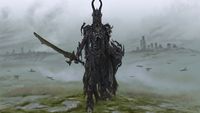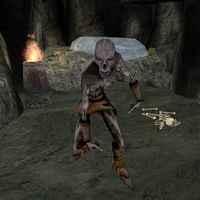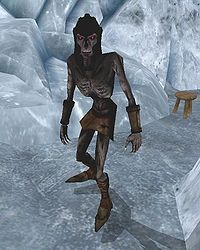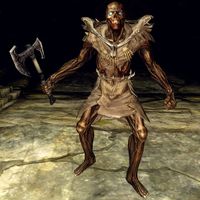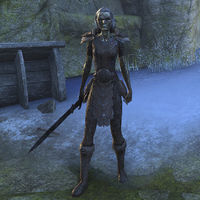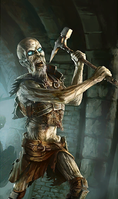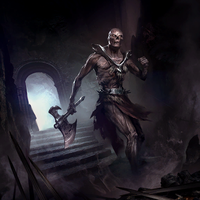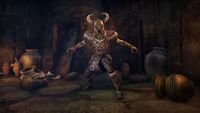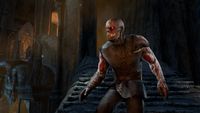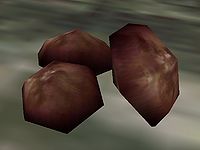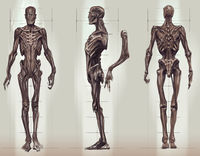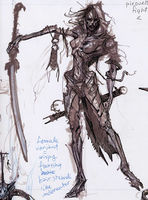Lore:Draugr
| Draugr | |||
|---|---|---|---|
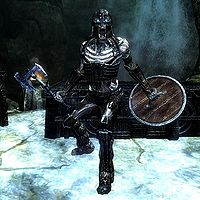 A Draugr (Skyrim)
A Draugr (Skyrim) |
|||
| Type | Undead (Reanimated) | ||
| Range | Skyrim, Solstheim | ||
| Appears in | |||
Draugr are a form of ancient Nord dead found in Skyrim and Solstheim.[1] Their bodies were mummified prior to reanimation, protecting their ligaments and muscle from the detrimental effects of rot.[2]
Draugr retain many of their former human skills and thus can greatly differ in their combat preferences, much like living humans. Some draugr will charge in on intruders wielding their battleaxes or greatswords, while others keep their distance and use their bow and arrows, yet others are very proficient with magic and can sometimes even be seen summoning high-level Atronachs. Many Draugr speak using the Dragon Language, and are also known to have the ability to use the Thu'um.[3]
Skyrim[edit]
The variety found in Skyrim dwell within ancient Nordic barrows and are usually associated with the Dragon Cult. In life, many were followers of a Dragon Priest (though others can be found guarding nobility or treasures).[1][3] When the Priest died, their followers were made undead and buried with them. The followers would rise from their resting places in shifts to worship at the sarcophagus of the Priest, transferring their life force to them, and to defend their barrow against unwanted intruders. They would then return to their graves and regenerate their life force while sleeping. It's speculated that these undead followers would have been indistinguishable from the living when the barrows were new.[1] Over time, the followers' bodies withered despite the ancient Nordic embalming techniques and they became the modern draugr of Skyrim. The local Nords mistakenly believe that the draugr were cursed with undeath for serving the dragons.[1][3] Bernadette Bantien of the College of Winterhold did much research into the nature of the draugr.
King Olaf One-Eye is found in Sovngarde by the Last Dragonborn while the draugr that his corpse became remains in its sarcophagus in Dead Man's Respite, even if it has not been slain, suggesting that the soul no longer occupies a draugr's body, having moved on to the afterlife. Conversely, it could mean that the soul goes to the afterlife while the draugr is at rest, and returns only when awakened.
Solstheim[edit]
The variety found on the island of Solstheim are different from their mainland brethren. They were once a tribe similar to the Skaal. Trapped and hungry on the island, they feasted on the flesh of their dead. The All-Maker saw this as a crime against nature, and cursed them to walk the land for eternity as undead, in search of more human flesh to consume. These draugr can often be found in the barrows of the island in search of flesh, and will fiercely attack and devour interlopers. An ingredient called gravetar can be extracted from defeated draugr, and can be used in alchemy. Draugr are occasionally slain as a rite of passage for male Skaal warriors.[4]
Draugr Lord Aesliip was once a mage of the Skaal who was banished for delving into necromancy. Through necromantic rituals he turned himself into a draugr so that he could eternally protect the island from a group of Frost Atronachs who planned to take it for themselves. He retained the ability to communicate. He was confronted by the Nerevarine in 3E 427, although accounts vary as to how he met his end.[4]
Gallery[edit]
See Also[edit]
- For game-specific information, see the Bloodmoon, Skyrim, and ESO articles. Additionally, some Draugr appear in the skeleton subtype in Legends.
Books[edit]
- Amongst the Draugr by Bernadette Bantien, College of Winterhold — Discoveries about the draugr and their link to the dragon cults
- Draugr and the Dragon Cult by Dragon Cult Chronicler, Skormvnir Kyrrund — A plea to honor and cherish the draugr of Skyrim
References[edit]
|
||||||||||||||||||||
